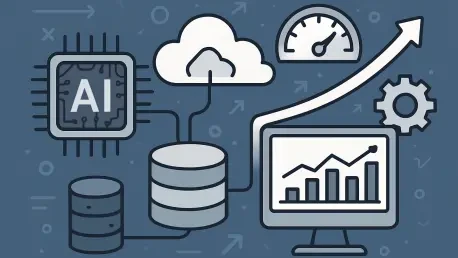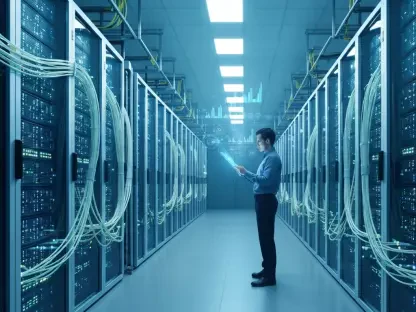I’m thrilled to sit down with Vijay Raina, a seasoned expert in enterprise IT infrastructure and high-performance computing. With years of experience in virtualization, networking, and optimizing AI workloads, Vijay has deep insights into leveraging technologies like Cisco UCS, Cisco switches, and VMware vSphere. Today, we’ll explore how businesses can transform their existing infrastructure into AI powerhouses, the critical role of networking in AI, and the practical steps to scale for future demands.
How has AI reshaped the landscape for businesses in recent years, and what shifts have you observed in their operational strategies?
AI has fundamentally changed how businesses operate, moving from a niche concept to a core driver of innovation. Just a few years ago, many companies saw AI as a futuristic experiment, but now it’s integral to everything from customer service with chatbots to critical applications like fraud detection and predictive analytics. I’ve seen organizations shift their strategies to prioritize data-driven decision-making, often embedding AI into their workflows to gain competitive edges. This has pushed IT teams to rethink infrastructure, focusing on compute power and scalability to handle these intensive workloads, often leveraging tools they already have in their data centers.
What are some of the toughest hurdles companies face when trying to support AI workloads with their existing IT setups?
One of the biggest challenges is the sheer resource demand of AI workloads. Training models or running real-time inference requires immense compute power, high-speed data access, and low-latency networking—something many legacy setups weren’t designed for. I often see companies struggling with outdated hardware that can’t support GPUs or with networks that bottleneck under large data transfers. There’s also a skills gap; IT teams familiar with traditional virtualization may not yet understand how to optimize for AI. Lastly, balancing cost with performance is tricky—many hesitate to invest in upgrades without clear ROI, even though their existing Cisco or VMware stack could often be adapted with minimal tweaks.
Why do you believe many enterprises already possess the foundational tools needed for AI, particularly with technologies like Cisco and VMware?
Most medium to large enterprises already run on robust platforms like Cisco UCS servers, Cisco switches, and VMware vSphere for their core operations and virtualization needs. These aren’t just reliable for traditional IT—they’re incredibly adaptable for AI with the right configuration. For instance, UCS servers can host powerful GPUs for deep learning, and VMware offers features like GPU passthrough for near bare-metal performance. The beauty is that these tools are familiar to IT teams, so there’s no need to start from scratch or learn entirely new systems. It’s about unlocking the potential already sitting in their data centers through strategic upgrades rather than a complete overhaul.
Can you share how Cisco UCS servers, initially designed for virtualization, have evolved to tackle AI workloads effectively?
Cisco UCS servers were built to consolidate compute resources for virtualized environments, but over time, they’ve transformed into beasts for high-performance computing, including AI. Newer models like the C-Series and B-Series are engineered with high-density computing in mind, supporting massive memory bandwidth and multiple GPUs. This makes them perfect for tasks like training complex models or running inference at scale. What’s impressive is how they integrate with enterprise needs—through tools like UCS Manager or Intersight, IT teams can quickly deploy and manage these servers for AI, using service profiles to streamline setup. It’s a natural evolution from hosting VMs to powering AI, leveraging the same trusted architecture.
What specific capabilities in newer UCS models make them stand out for AI applications?
The newer UCS C-Series and B-Series models are tailored for AI with several standout features. They support multiple high-end GPUs, which are critical for parallel processing in deep learning. They also offer high-speed memory and interconnects to ensure data flows quickly between components, reducing bottlenecks during training or inference. Additionally, their modular design allows for easy scalability—add more GPUs or servers as needed without disrupting operations. This flexibility, combined with robust cooling and power efficiency, ensures they can handle the intense demands of AI workloads while fitting seamlessly into existing data center environments.
How do GPUs integrate with UCS servers to boost performance for tasks like deep learning or inference?
GPUs are the heart of AI performance, and their integration with UCS servers is a game-changer. High-end options like the NVIDIA A100 or H100 can be slotted into UCS chassis, providing massive parallel processing power needed for deep learning training or real-time inference across thousands of data points. UCS servers are designed to maximize GPU performance with high-speed PCIe lanes and optimized power delivery, ensuring minimal latency. This setup allows enterprises to run complex models efficiently, whether it’s for image recognition or natural language processing, turning a standard server rack into an AI powerhouse with the right hardware pairing.
Why is networking such a pivotal element for AI workloads, especially when managing massive datasets?
Networking is the backbone of AI workloads because these applications are incredibly data-hungry. Training a model or running inference often involves moving terabytes of data between storage, memory, and GPUs at lightning speed. If your network can’t keep up, you get bottlenecks that slow everything down, no matter how powerful your servers are. Low latency and high throughput are non-negotiable, especially for distributed training across multiple nodes. A robust network ensures data flows seamlessly, making it possible to process large datasets efficiently and keep AI pipelines running smoothly.
How can Cisco Nexus or Catalyst switches be optimized to meet the high-speed, low-latency demands of AI applications?
Cisco Nexus and Catalyst switches are already widely deployed in enterprises, and with some tuning, they can handle AI’s demands. For high-speed needs, you can configure Nexus 9000 series switches to support 100GbE or higher, ensuring massive bandwidth. Enabling features like jumbo frames and quality of service (QoS) prioritizes AI traffic, reducing latency. For distributed GPU training, setting up lossless Ethernet with priority flow control (PFC) prevents data loss during high-volume transfers. Using a leaf-spine architecture also helps by minimizing hops and ensuring efficient data routing. These adjustments transform existing switches into AI-ready infrastructure without needing a full replacement.
Can you explain what RDMA over Converged Ethernet (RoCE) is and its significance for distributed GPU training?
RDMA over Converged Ethernet, or RoCE, is a protocol that allows direct memory-to-memory data transfers between servers without involving the CPU, which drastically cuts latency and boosts efficiency. For distributed GPU training, where multiple servers and GPUs need to synchronize massive datasets and model parameters in real time, RoCE is invaluable. It enables near-instant communication between nodes, ensuring training jobs aren’t slowed by network overhead. With Cisco Nexus switches, you can configure RoCE to create a high-performance fabric that supports these intensive AI tasks, making it a critical piece for scaling AI across a cluster.
How does VMware’s vSphere platform facilitate the management of AI workloads alongside traditional IT applications?
VMware vSphere is a powerhouse for managing both AI and traditional IT workloads under one roof. It provides a centralized platform to run virtual machines, allowing IT teams to allocate resources dynamically—whether for a legacy app or an AI training job. For AI, vSphere supports GPU integration through passthrough or virtual GPU sharing, ensuring high performance for compute-heavy tasks. Its fault tolerance and resource scheduling features also mean you can balance workloads efficiently, preventing AI jobs from hogging resources needed elsewhere. This unified approach simplifies operations, letting teams manage everything with familiar tools while meeting diverse demands.
What advice do you have for our readers who are looking to adapt their existing infrastructure for AI workloads?
My advice is to start with what you already have and build from there. Take inventory of your Cisco UCS servers, networking gear, and VMware setups—chances are, they’re more capable than you think. Begin small by adding GPUs to a few servers or enabling GPU passthrough in vSphere to test AI workloads. Focus on network optimization; even simple tweaks like enabling jumbo frames or QoS on your switches can make a big difference. Train your IT team on AI-specific configurations rather than outsourcing everything. Finally, prioritize data security and compliance by keeping sensitive workloads on-prem. With an evolutionary approach, you can unlock AI potential without breaking the bank or starting over.









